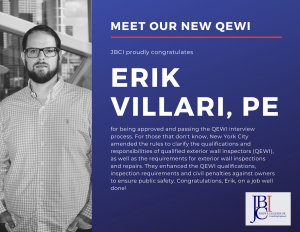It has been said that 90 percent of all water intrusion occurs within 1 percent of the total building exterior. Water damage and the associated problems are extremely costly and cause significant interruptions to your facilities. Quickly identifying the water intrusions source(s) in existing buildings can be challenging and requires a knowledge of the in-situ building envelope construction. Our goal is to educate facility managers on methods to identify, mitigate and repair water intrusion into existing buildings. We also aim to educate managers on some of the common design and construction façade waterproofing pitfalls and relatively inexpensive ways to prevent them.
It is important to understand the basic behavior of the two main façade construction types, 1) barrier wall and 2) cavity wall. Common construction includes brick masonry, Exterior insulation and finish system (EIFS), precast, curtainwalls and concrete. Proper waterproofing at the interface between the building envelope elements include roof, façade, windows, foundations and plazas.
Understanding of how each building envelope component interacts with one another is key to identifying how water can travel within a wall. Then we can better identify the source of the leaks and effective corrective actions. Without this knowledge, there is a high probability that money will be wasted on improperly designed and constructed repair measures, and the water intrusion and interior damage will continue.
Let’s face it, parking garage structures are not exciting. They are often considered utilitarian and may be ignored. All parking garages require routine cleaning and maintenance to preserve and extend the service life of the structure. However, maintenance of parking garages is often deferred in favor of buildings. This deferred maintenance can lead to premature distress and deterioration and cause more extensive and costly repairs for an Owner or Operator.
Parking garage structures are subject to a very hostile environment and experience more distress and deterioration than a building. Similar to bridges, garages must resist vehicle traffic, weather, moisture, temperature fluctuations, ultraviolet light and deicing chemicals. A parking structure’s ability to resist these elements, and its general long-term performance is primarily influenced by a maintenance program.
All parking garages must have a routine maintenance program. This maintenance program should be considered preventative and will help reduce the overall repair costs over the life of the garage. The maintenance program tasks should be identified to occur on daily, weekly, quarterly or an annual frequency. These maintenance tasks will usually be performed by Owner or Operator personnel using prepared checklists.
A good maintenance program starts with an annual visual inspection of the garage. The annual inspection can be performed by Owner or Operator personnel or a professional consultant. During this annual inspection, any distress or deterioration conditions (i.e. cracks, sealant damage, water intrusion, etc.) must be recorded on checklists and garage plans. Once identified, the Owner or Operator should initiate a repair program to address any observed distress or deterioration conditions.
Another important aspect in a maintenance program is regular cleaning and washing of the parking garage. A complete washdown of the garage floors should be performed on a bi-annual basis (i.e. Spring and Fall). This will help remove accumulated dirt and debris from the garage on a regular basis. The Spring washdown is especially important to remove road salts and deicing chemicals that are brought into the garage during the winter months.
Finally, every maintenance program should include a structural assessment of the garage by a professional consultant every three to five years. The frequency of this assessment will greatly depend upon the age and condition of the parking garage. Following this assessment, the professional should provide prioritized repair recommendations and a probable construction cost for any identified repairs. This will allow the Owner or Operator to plan and budget for any necessary repairs. Repair programs for parking garages can be challenging, but when well planned, they can be done efficiently and minimize the disruption of garage operations.
 JBCI proudly congratulates Erik Villari, PE for being approved and passing the QEWI interview process. For those that don’t know, New York City amended the rules to clarify the qualifications and responsibilities of qualified exterior wall inspectors (QEWI), as well as the requirements for exterior wall inspections and repairs. They enhanced the QEWI qualifications, inspection requirements and civil penalties against owners to ensure public safety. Congratulations, Erik, on a job well done!
JBCI proudly congratulates Erik Villari, PE for being approved and passing the QEWI interview process. For those that don’t know, New York City amended the rules to clarify the qualifications and responsibilities of qualified exterior wall inspectors (QEWI), as well as the requirements for exterior wall inspections and repairs. They enhanced the QEWI qualifications, inspection requirements and civil penalties against owners to ensure public safety. Congratulations, Erik, on a job well done!

 JBCI proudly congratulates Erik Villari, PE for being approved and passing the QEWI interview process. For those that don’t know, New York City amended the rules to clarify the qualifications and responsibilities of qualified exterior wall inspectors (QEWI), as well as the requirements for exterior wall inspections and repairs. They enhanced the QEWI qualifications, inspection requirements and civil penalties against owners to ensure public safety. Congratulations, Erik, on a job well done!
JBCI proudly congratulates Erik Villari, PE for being approved and passing the QEWI interview process. For those that don’t know, New York City amended the rules to clarify the qualifications and responsibilities of qualified exterior wall inspectors (QEWI), as well as the requirements for exterior wall inspections and repairs. They enhanced the QEWI qualifications, inspection requirements and civil penalties against owners to ensure public safety. Congratulations, Erik, on a job well done!